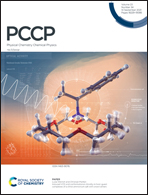Quantum-state-dependent decay rates of electrostatically trapped Rydberg NO molecules
Abstract
Nitric oxide (NO) molecules travelling in pulsed supersonic beams have been prepared in long-lived Rydberg–Stark states by resonance-enhanced two-colour two-photon excitation from the X 2Π1/2 (v′′ = 0, J′′ = 3/2) ground state, through the A 2Σ+ (v′ = 0, N′ = 0, J′ = 1/2) intermediate state. These excited molecules were decelerated from 795 ms−1 to rest in the laboratory-fixed frame of reference, in the travelling electric traps of a transmission-line Rydberg–Stark decelerator. The decelerator was operated at 30 K to minimise effects of blackbody radiation on the molecules during deceleration and trapping. The molecules were electrostatically trapped for times of up to 1 ms, and detected in situ by pulsed electric field ionisation. Measurements of the rate of decay from the trap were performed for states with principal quantum numbers between n = 32 and 50, in Rydberg series converging to the N+= 0, 1, and 2 rotational states of NO+. For the range of Rydberg states studied, the measured decay times of between 200 μs and 400 μs were generally observed to reduce as the value of n was increased. For some particular values of n deviations from this trend were seen. These observations are interpreted, with the aid of numerical calculations, to arise as a result of contributions to the decay rates, on the order of 1 kHz, from rotational and vibrational channel interactions. These results shed new light on the role of weak intramolecular interactions on the slow decay of long-lived Rydberg states in NO.



 Please wait while we load your content...
Please wait while we load your content...